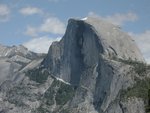Zion National Park Announces Limited Trail Closures and Road Delays for Aerial Herbicide Spraying and Seeding Project
Date: September 8, 2009
Contact: David Eaker, 435-772-7811
Contact: Cheryl Decker, 435-772-0216
Zion National Park Superintendent Jock Whitworth has announced that the park will begin aerial application of herbicide and seeding and on approximately 4,600 acres of the 2006 Kolob Fire burned area starting on September 14, 2009. These areas include the Kolob Terrace Road, Coal Pits Wash and Dalton Wash. This aerial spraying of herbicide (3,100 acres) and seeding (1,500 acres) will cause the temporary closure of some of the area trails including Grapevine, Right Fork of North Creek and Coal Pits Trails and cross country hiking in the Dalton Wash area. There may also be some short-term road delays along the Kolob Terrace Road as the spraying and seeding is done in this area. Because of the remote and rough terrain in the burn area, application of the herbicide and seed will be done by a contracted helicopter. The project is expected to last for approximately two weeks, but could be longer if weather conditions are unfavorable.
In June 2006, the Kolob Fire burned 10,516 acres in the southeastern portion of Zion National Park making it the largest wildfire in the park’s history. Most of the affected area was along the Kolob Terrace Road and the Crater Hill area at the end of the Dalton Wash Road. A Burned Area Emergency Rehabilitation (BAER) team was brought in to assess the fire and found a significant threat of invasion by non-native cheatgrass (Bromus tectorum). This was of particular concern due to cheatgrass’s ability to establish and maintain dominance over native vegetation and create an annual fire hazard. In response to this, the park conducted an Environmental Assessment (EA) after the fire to address issues relating to a proposal to aerially apply herbicide to the affected area to reduce the cheatgrass. Herbicide spraying and re-seeding began in the fall of 2006 after a Finding of No Significant Impact related to the EA.
The previous herbicide treatment has been very successful in reducing the amount of cheatgrass that invaded most of the burned area. However, due to uncontrollable environmental conditions at the time of the original aerial spraying, the natives have not yet established consistent cover in many areas. Many open areas remain where cheatgrass could gain a foothold and compete with native vegetation for available water, nutrients and light. Because the herbicide applied in 2006 is at the end of its effective timeframe, it will not prevent future establishment of cheatgrass. Along with the herbicide spraying, the park will also be re-seeding some of the burned areas with locally collected native seeds in hopes that they will establish themselves before the cheatgrass can. Park managers have determined that re-application of herbicide and re-seeding of native material would be the most effective treatment for the burned area.
Zion National Park Announces Limited Trail Closures and Road Delays for Aerial Herbicide Spraying and Seeding Project
All posts are those of the individual authors and the owner
of this site does not endorse them. Content should be considered opinion
and not fact until verified independently.
Sorry, only registered users may post in this forum.


